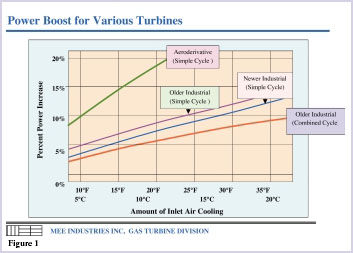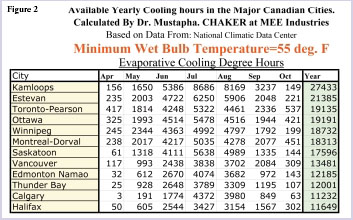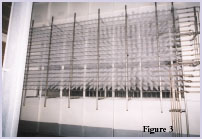Need More Power? TransAlta Energy Cogeneration, located in Mississauga, Ontario, operates two GE LM 6000 aeroderivative, base-loaded turbines (each rated at 42 MW). TransAlta’s interest in fog cooling is based on the fact that gas turbine power drops with increasing ambient temperatures. Essentially, TransAlta sells electricity to a local utility, and provides steam, compressed air, demineralized water and emergency standby power to a nearby manufacturing facility.
The plant’s existing 800-ton absorption chiller proved to be too small for the task of cooling inlet air and therefore the facility couldn’t boost power production during the hot summer months (See Figure 1, Power Boost). Economic costs precluded the addition of a larger chiller system, because the plant needed about 1600 tons of chilling per unit to provide enough inlet air cooling. Thus, TransAlta decided to install fog. “With our absorption chiller, we were only getting about 25 percent cooling capacity per machine,” said the plant manager.“We chose fog as it is a lot cheaper to install and run than a chiller.”
The facility immediately installed a fog system. The design they used incorporates 224 impaction-pin nozzles and the system operates at 2,000 psi with a maximum fog water flow rate of 5.0 gpm per turbine. Each turbine has a 10 hp pump unit. Temperature and humidity sensors system’s four stages of cooling. The installed fog boosts the output of the combustion turbines during hot days. And as a result, combustion turbine operators have more power as demand soars, and spot prices are at their peak, sometimes selling for ten times the regular rate.
“We’re very happy with fog and count on it for the extra power,” said the plant manager. “Depending on ambient conditions, we can get about 2-3 MW per machine—a 6% gain. We start-up the cooling systems in April and shut down in November. After winterizing the fog we’ve gone ahead and run it again in a late fall heat wave, the final shut down and freeze protection doesn’t take long.”
Determining Cooling Potential
To determine the amount of cooling that can be produced by evaporation at a given location at a given time, two temperature readings are necessary:
“Dry bulb temperature” – The ambient temperature taken with an ordinary thermometer.
“Wet bulb temperature” – The temperature taken using a thermometer whose sensing bulb is covered with a wet wick.
The difference between the two readings, the “wet bulb depression”, shows how much the air temperature can be lowered through evaporative cooling. With a dry bulb temperature of 80 degrees and a wet bulb reading of 60 degrees, the wet bulb depression is 20 degrees. By taking these readings every hour for a year, you can determine the number of evaporative cooling-degree-hours (ECDH) that can be achieved in a specific climate. For example, if the wet bulb depression is 10 degrees for 8 hours, rising to 25 degrees for four hours, you have 180 cooling-degree-hours for that day. Based on data from the National Climatic Data Center, one can calculate the number of monthly and annual cooling-degreehours across the country. (A minimum wet bulb temperature of 55 degrees Fahrenheit was used as a cutoff point to prevent the possibility of inlet icing.)
By calculating the number of evaporative coolingdegree-hours for your location, an individual can estimate the amount of generating capacity that is being lost every year. As a rule of thumb for most gas turbines, each degree of increase in air temperature results in an output power loss of about 0.4 percent with a similar gain when inlet cooling is applied. Taking the generating capacity of the power plant and multiplying it by the number of ECDH per year and then taking 0.4 percent of that figure will give you the amount of additional energy that can be obtained through inlet fogging.
In Kamloops, for example, there aren’t many cooling degrees hours available from October through April. In the other five months, however, there are 27,143 CDH and in the critical months of July and August the CDH is over 8,000 each month (See Figure 2, Available Yearly Cooling Hours.)
Fog System Basics
Conceptually, the fog system is quite simple. Demineralized water is pumped under high-pressure to hundreds of fog nozzles strung across the inlet air duct (See Figure 3, Fog Nozzle Manifolds). Tiny openings in each nozzle shoot an ultra-fine jet of water against a metal pin creating a shower of droplets much like the spray you get by putting your thumb over a garden hose, the difference is the droplets' size.
The power boost achieved is not a function of water volume injected; it is a result of the cooler air. Cooling by evaporation must occur in a matter of seconds. Ideally, small droplets will stay in the airflow, float around objects in their path, and if ingested into the compression stage will evaporate as the temperature rises and air is compressed. Cooling in the compressor is also a valid way to boost power. All of the small droplets eventually evaporate, and the goal is to create a spray that gives large numbers of small droplets at 10 microns with most of the water volume consisting of droplets less than 20 microns in diameter.
When measuring droplet size it is important to take into account many things: air speed, measuring distance from nozzle, and the conditions created when billions of droplets are released all at once. Studies have shown that impaction-pin nozzles are operating in the “sweet spot” where just enough water is delivered with just the right force. If even a seemingly minor adjustment were made, the forces splitting the water into droplets would lose significant strength. For instance, one specification calls for twice the flow rate at half the pressure. In a design using these high flow nozzles, fewer nozzles are used resulting in dry spots in the cross section, corridors of air flow that never get water delivered to them. The same problem can be observed in traditional media type evaporative cooling systems where dry spots can occur on the honeycomb media due to headers clogging or a poor design.
Background
When a fog system is properly designed customers benefit by having energy solutions they can count on. The fog system guarantees a number of benefits: increases in power output of as much as 30%, improvement in fuel efficiency by 5% or more, and reduced NOx emissions. MeeFog™ offers a quick and simple installation.
The plant’s existing 800-ton absorption chiller proved to be too small for the task of cooling inlet air and therefore the facility couldn’t boost power production during the hot summer months (See Figure 1, Power Boost). Economic costs precluded the addition of a larger chiller system, because the plant needed about 1600 tons of chilling per unit to provide enough inlet air cooling. Thus, TransAlta decided to install fog. “With our absorption chiller, we were only getting about 25 percent cooling capacity per machine,” said the plant manager.“We chose fog as it is a lot cheaper to install and run than a chiller.”
The facility immediately installed a fog system. The design they used incorporates 224 impaction-pin nozzles and the system operates at 2,000 psi with a maximum fog water flow rate of 5.0 gpm per turbine. Each turbine has a 10 hp pump unit. Temperature and humidity sensors system’s four stages of cooling. The installed fog boosts the output of the combustion turbines during hot days. And as a result, combustion turbine operators have more power as demand soars, and spot prices are at their peak, sometimes selling for ten times the regular rate.
“We’re very happy with fog and count on it for the extra power,” said the plant manager. “Depending on ambient conditions, we can get about 2-3 MW per machine—a 6% gain. We start-up the cooling systems in April and shut down in November. After winterizing the fog we’ve gone ahead and run it again in a late fall heat wave, the final shut down and freeze protection doesn’t take long.”

Determining Cooling Potential
To determine the amount of cooling that can be produced by evaporation at a given location at a given time, two temperature readings are necessary:
“Dry bulb temperature” – The ambient temperature taken with an ordinary thermometer.
“Wet bulb temperature” – The temperature taken using a thermometer whose sensing bulb is covered with a wet wick.
The difference between the two readings, the “wet bulb depression”, shows how much the air temperature can be lowered through evaporative cooling. With a dry bulb temperature of 80 degrees and a wet bulb reading of 60 degrees, the wet bulb depression is 20 degrees. By taking these readings every hour for a year, you can determine the number of evaporative cooling-degree-hours (ECDH) that can be achieved in a specific climate. For example, if the wet bulb depression is 10 degrees for 8 hours, rising to 25 degrees for four hours, you have 180 cooling-degree-hours for that day. Based on data from the National Climatic Data Center, one can calculate the number of monthly and annual cooling-degreehours across the country. (A minimum wet bulb temperature of 55 degrees Fahrenheit was used as a cutoff point to prevent the possibility of inlet icing.)
By calculating the number of evaporative coolingdegree-hours for your location, an individual can estimate the amount of generating capacity that is being lost every year. As a rule of thumb for most gas turbines, each degree of increase in air temperature results in an output power loss of about 0.4 percent with a similar gain when inlet cooling is applied. Taking the generating capacity of the power plant and multiplying it by the number of ECDH per year and then taking 0.4 percent of that figure will give you the amount of additional energy that can be obtained through inlet fogging.

In Kamloops, for example, there aren’t many cooling degrees hours available from October through April. In the other five months, however, there are 27,143 CDH and in the critical months of July and August the CDH is over 8,000 each month (See Figure 2, Available Yearly Cooling Hours.)
Fog System Basics
Conceptually, the fog system is quite simple. Demineralized water is pumped under high-pressure to hundreds of fog nozzles strung across the inlet air duct (See Figure 3, Fog Nozzle Manifolds). Tiny openings in each nozzle shoot an ultra-fine jet of water against a metal pin creating a shower of droplets much like the spray you get by putting your thumb over a garden hose, the difference is the droplets' size.
The power boost achieved is not a function of water volume injected; it is a result of the cooler air. Cooling by evaporation must occur in a matter of seconds. Ideally, small droplets will stay in the airflow, float around objects in their path, and if ingested into the compression stage will evaporate as the temperature rises and air is compressed. Cooling in the compressor is also a valid way to boost power. All of the small droplets eventually evaporate, and the goal is to create a spray that gives large numbers of small droplets at 10 microns with most of the water volume consisting of droplets less than 20 microns in diameter.
When measuring droplet size it is important to take into account many things: air speed, measuring distance from nozzle, and the conditions created when billions of droplets are released all at once. Studies have shown that impaction-pin nozzles are operating in the “sweet spot” where just enough water is delivered with just the right force. If even a seemingly minor adjustment were made, the forces splitting the water into droplets would lose significant strength. For instance, one specification calls for twice the flow rate at half the pressure. In a design using these high flow nozzles, fewer nozzles are used resulting in dry spots in the cross section, corridors of air flow that never get water delivered to them. The same problem can be observed in traditional media type evaporative cooling systems where dry spots can occur on the honeycomb media due to headers clogging or a poor design.

Background
When a fog system is properly designed customers benefit by having energy solutions they can count on. The fog system guarantees a number of benefits: increases in power output of as much as 30%, improvement in fuel efficiency by 5% or more, and reduced NOx emissions. MeeFog™ offers a quick and simple installation.







